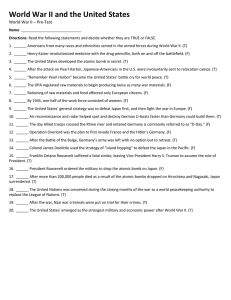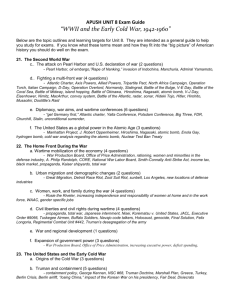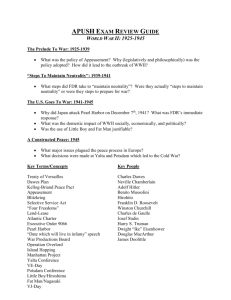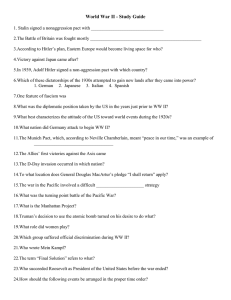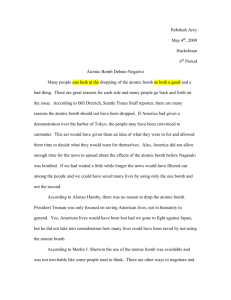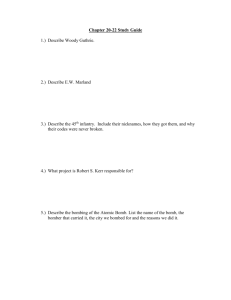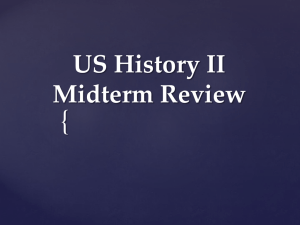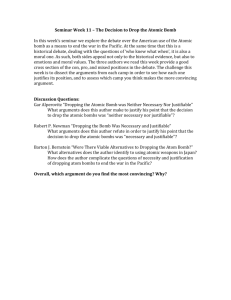Ch 25 Reading Guide (all)
advertisement
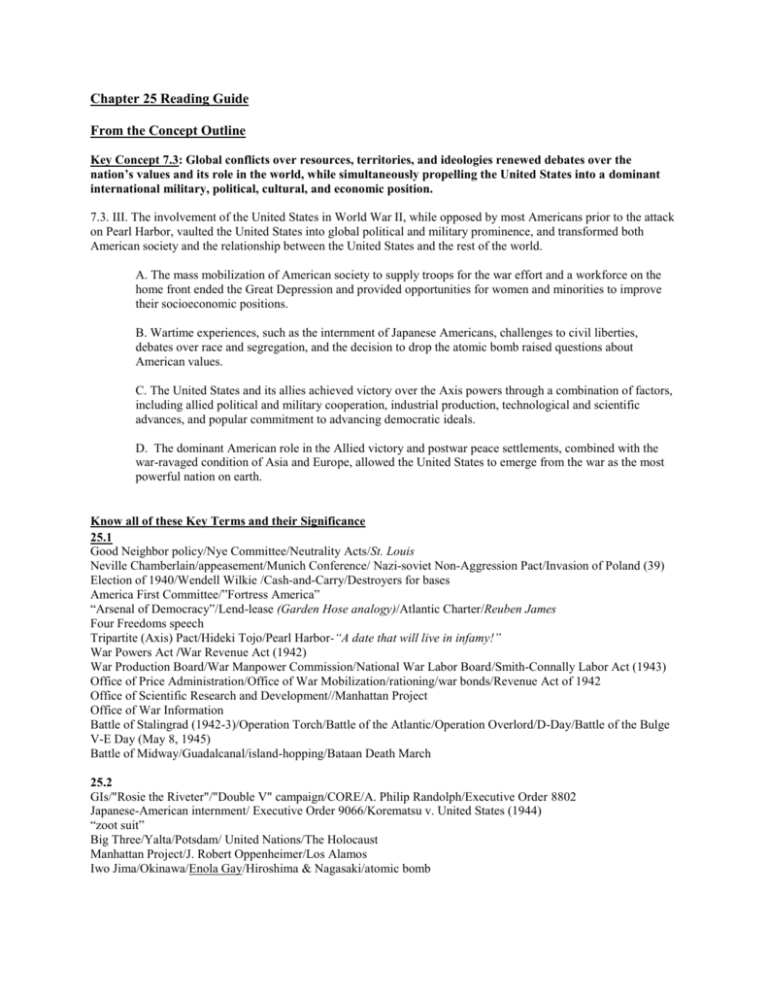
Chapter 25 Reading Guide From the Concept Outline Key Concept 7.3: Global conflicts over resources, territories, and ideologies renewed debates over the nation’s values and its role in the world, while simultaneously propelling the United States into a dominant international military, political, cultural, and economic position. 7.3. III. The involvement of the United States in World War II, while opposed by most Americans prior to the attack on Pearl Harbor, vaulted the United States into global political and military prominence, and transformed both American society and the relationship between the United States and the rest of the world. A. The mass mobilization of American society to supply troops for the war effort and a workforce on the home front ended the Great Depression and provided opportunities for women and minorities to improve their socioeconomic positions. B. Wartime experiences, such as the internment of Japanese Americans, challenges to civil liberties, debates over race and segregation, and the decision to drop the atomic bomb raised questions about American values. C. The United States and its allies achieved victory over the Axis powers through a combination of factors, including allied political and military cooperation, industrial production, technological and scientific advances, and popular commitment to advancing democratic ideals. D. The dominant American role in the Allied victory and postwar peace settlements, combined with the war-ravaged condition of Asia and Europe, allowed the United States to emerge from the war as the most powerful nation on earth. Know all of these Key Terms and their Significance 25.1 Good Neighbor policy/Nye Committee/Neutrality Acts/St. Louis Neville Chamberlain/appeasement/Munich Conference/ Nazi-soviet Non-Aggression Pact/Invasion of Poland (39) Election of 1940/Wendell Wilkie /Cash-and-Carry/Destroyers for bases America First Committee/”Fortress America” “Arsenal of Democracy”/Lend-lease (Garden Hose analogy)/Atlantic Charter/Reuben James Four Freedoms speech Tripartite (Axis) Pact/Hideki Tojo/Pearl Harbor-“A date that will live in infamy!” War Powers Act /War Revenue Act (1942) War Production Board/War Manpower Commission/National War Labor Board/Smith-Connally Labor Act (1943) Office of Price Administration/Office of War Mobilization/rationing/war bonds/Revenue Act of 1942 Office of Scientific Research and Development//Manhattan Project Office of War Information Battle of Stalingrad (1942-3)/Operation Torch/Battle of the Atlantic/Operation Overlord/D-Day/Battle of the Bulge V-E Day (May 8, 1945) Battle of Midway/Guadalcanal/island-hopping/Bataan Death March 25.2 GIs/"Rosie the Riveter"/"Double V" campaign/CORE/A. Philip Randolph/Executive Order 8802 Japanese-American internment/ Executive Order 9066/Korematsu v. United States (1944) “zoot suit” Big Three/Yalta/Potsdam/ United Nations/The Holocaust Manhattan Project/J. Robert Oppenheimer/Los Alamos Iwo Jima/Okinawa/Enola Gay/Hiroshima & Nagasaki/atomic bomb You should be able to answer all of the following questions. Think of your outlines as a way to answer these questions….this gives your outlining a purpose. 25.1 – to page 798, “War and American Society” 1. What was the Good Neighbor Policy? Why were Americans supporting a neutral position in the 1930s regarding the growing political and military tensions in Europe? What were the main arguments of the isolationists vs the interventionists? 2. How did Roosevelt manage to get aid to Great Britain in 1939 and 1940 despite the limitations imposed by the Neutrality Acts? Consider policies aimed at helping other countries resist Axis expansion and efforts to put the country on a war footing. 3. Consider visiting this VERY COOL INTERACTIVE SITE where you can relive the events leading the US to war and make US policy decisions each step of the way: http://teachingamericanhistory.org/static/neh/interactives/neutrality/ 4. Why was oil a major source of conflict between the US and Japan in the early 1940s? What other areas of disagreement existed between the two nations in the fall of 1941? 5. How did America mobilize for war in World War II? Consider government organizations, major economic and social trends, labor, and the role of technological innovation. 6. What region of the country benefited most from the enormous government spending for the war effort? Why? 7. What efforts did the national government make to regulate production, labor, and prices during the war? How successful were they? 8. Describe United States military strategy in the European and Pacific theaters from 1942 to 1945. Identify at least three major campaigns, battles, and/or strategies in each theater of the war. 25.2 – p. 798-813 9. Describe the demographic, social, and military changes for African Americans and Mexican Americans during World War II. 10. What role did propaganda play in WWII? How did it compare to WWI? 11. How were the women who filled war jobs treated? What obstacles did they face? 12. What was a "zoot suit?" How did this apparel create racial tensions in Los Angeles during World War II? 13. What was the key issue in the case of Korematsu v. US? How did the Supreme Court rule? 14. What were the major outcomes of the Yalta Conference? What had changed by Potsdam, later that year? 15. What strategy did the US use in fighting the Japanese in the Pacific? 16. - “Dropping the atomic bomb was a necessary measure taken by the US to end WWII.” Defend this argument. - “Dropping the atomic bomb was an unnecessary act of aggression on the part of the US.” Defend this argument.
